Book Review: ‘Designing for Emotion’ helps people connect with your website
 Designing for Emotion by Aarron Walter is the fifth release in the A Book Apart series aimed at those in the web industry. Don’t let the small size fool you — Designing for Emotion is packed with a number of excellent points and examples for designers to reference when creating an interface.
Designing for Emotion by Aarron Walter is the fifth release in the A Book Apart series aimed at those in the web industry. Don’t let the small size fool you — Designing for Emotion is packed with a number of excellent points and examples for designers to reference when creating an interface.
Walter identifies that facilitating human-to-human communication is emotional design’s primary goal. When you consider human interaction, it’s important to remember that a positive personality fosters trust between people. Walter suggest a number of simple tactics relating to imagery, color, and interaction to mirror that real-life experience on the web.
Designing for Emotion makes the point that users will connect more with a brand when the website builds that trust. In my experience on the web, nothing seems to invalidate my trust in a brand more than identifying a website as a cookie-cutter template experience.
Another lesson from this book is that people want what they can’t have. Twitter chose to use this tactic when they launched their latest interface upgrade in the fall of 2010.
Leaking limited screenshots online followed by rolling out the upgrade to a handful of users at first used mystery and exclusivity as emotional tools to get people excited. Twitter’s redesign also utilized the Golden Ratio. Using this visual design principle we have come to subconsciously love and recognize, users felt pleased when navigating the new interface.
The Twitter redesign is just one of many examples fromDesigning for Emotion. From chapter to chapter you’ll discover many great examples of how to emotionally connect to humans, convey personality, engage the user, seek forgiveness and reward, and harness trust.
How have we here at RainStorm Consulting been using emotional design tactics? One example we launched earlier this month is an upgrade to the interface of the Maine Center on Aging. Utilizing relatable human imagery in the interface, as well as enjoyable interactive elements such as information sliders, we upgraded from their previous less-active interface. Brighter color palettes as well as uniquely displaying content makes the experience trustworthy, clear, and even fun!
It’s important to remember that certain emotional design aspects are not appropriate for all situations. The designer must identify how to instill trust and ease in the user for different scenarios. It takes time to refine designs and make them more emotional, something this book will be a strong reference guide for.
One impressive example Walter highlights is the case of Blue Sky Resumes. How did Blue Sky Resumes increase their conversion rates significantly just from an emotional website design? Pick up your copy today to find out!
Editor’s note: This is part of an ongoing series of posts highlighting books on the craft of web design. If you know a great book we should review, tell us at contact@rainstormconsulting.com.
